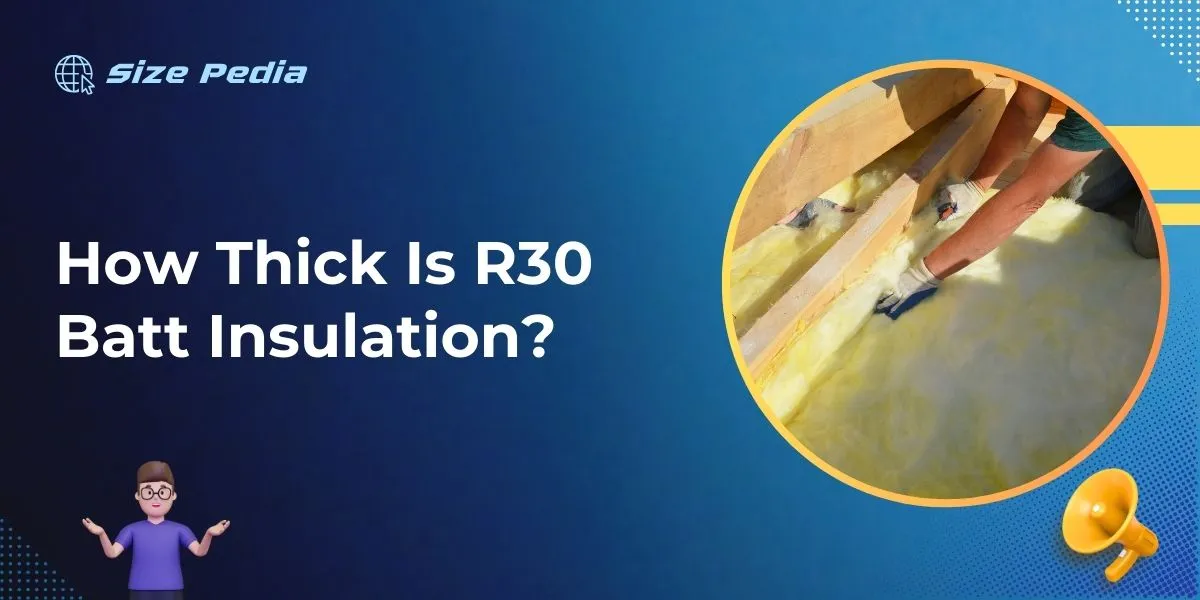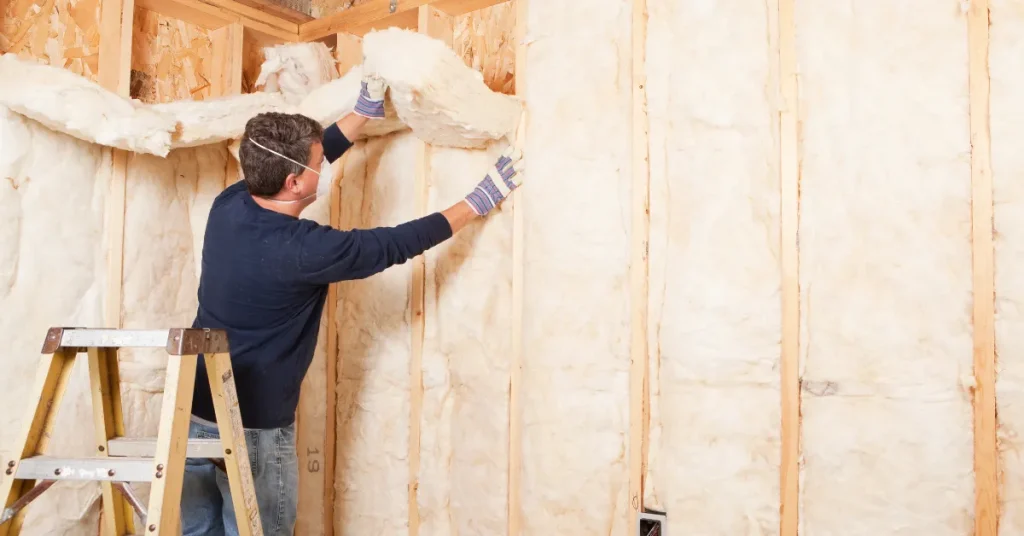R30 batt insulation typically measures around 9.5 inches thick. This thickness is standard for providing effective thermal resistance.
Proper insulation is crucial for maintaining comfortable temperatures in your home and for reducing energy costs. R30 batt insulation, known for its high R-value per inch, is a common choice for residential and commercial buildings, especially in cooler climates.
It’s designed to fit conveniently between standard spaced framing, such as studs and joists, ensuring a snug installation that prevents energy leaks.
Homeowners and builders seek this type of insulation for its effectiveness in attics, walls, and floors, favoring its simplicity in installation and its eco-friendly options.
R30 batts are made from various materials, including fiberglass, mineral wool, and recycled content, offering a range of choices to meet both thermal needs and sustainability goals.

R30 Batt Insulation Dimensions
When thinking about insulating a space, R30 batt insulation is a common choice. Its effectiveness is linked to its unique dimensions and material, designed to provide a high level of thermal resistance.
Understanding R30 insulation is key to ensuring proper installation and energy efficiency for your home or project. Let’s dive into the specifics.
Material Composition
At the heart of R30 batt insulation lies its material composition. This insulation is generally made from fiberglass or mineral wool, substances known for their excellent thermal resistance. They are:
- Durable
- Moisture-resistant
- Non-combustible
Standard Measurements
R30 batt insulation comes in standardized sizes that fit typical residential and commercial framing. This ensures that installation is streamlined and gaps are minimized. The standard measurements are:
| Dimension | Value |
| Width | 16 or 24 inches |
| Length | typically 48 or 96 inches |
| Thickness | approximately 9.5 inches |
The thickness of R30 insulation is particularly important as it corresponds to its R-value – the measure of thermal resistance. With a thicker material, less heat is lost, making R30 an excellent choice for colder climates.
Insulation Effectiveness
Keeping your home cozy and energy-efficient is vital. R30 batt insulation delivers this by trapping warmth during winter and cool air in summer.
But how effective is it? Let’s delve into the science of R30 insulation and examine its performance in different climates. Understanding these details ensures your home stays comfortable year-round.
R-value Explained
R-value measures how well insulation resists heat flow. Higher R-values mean better insulation power. R30 batt insulation is often around 9.5 to 12.25 inches thick. This thickness provides a robust barrier against heat loss or gain.
Here’s a quick look at the R-value thickness relationship:
| R-Value | Thickness (inches) |
| R30 | 9.5 – 12.25 |
Note: Insulation thickness can vary by material and manufacturer.
Climate Considerations
Different climates require different insulation levels. Thicker R30 is best for colder zones. In mild zones, lower R-values might suffice.
Climate zones and recommended R-values:
- Zone 1: R30 to R49 – Attics in cold areas
- Zone 2: R30 to R38 – Attics in moderate zones
Choosing the right insulation thickness for your climate is essential. Doing so can cut energy bills and improve comfort.
Always consult a local expert to select the most suitable R-value for your home. This ensures optimal insulation effectiveness, tailored to your specific needs.
Installation Insights

Welcome to the ‘Installation Insights’ section of our discussion on R30 batt insulation. Before diving into the thick layers of insulation, let’s prepare to tackle the installation process.
Optimized installation ensures maximum efficiency and performance. Here we detail how to gear up for the task and navigate through common challenges.
Preparation Steps
Good preparation is key to a smooth insulation process. Master these steps:
- Measure twice, cut once: Confirm the space dimensions.
- Get the right tools: Have a sharp knife and straightedge ready.
- Wear protective gear: Don gloves, long sleeves, and safety glasses.
- Clear the area: Ensure no debris or moisture will hinder the insulation.
- Check for air leaks: Seal any gaps before insulation.
Common Installation Challenges
Even with the best prep, you may hit snags. Be ready for these:
| Challenge | How to Overcome |
| Batt sizing issues | Trim insulation for a snug, not tight, fit between joists. |
| Difficult spaces | Use smaller pieces to fill nooks and crannies properly. |
| Moisture control | Install a vapor barrier to protect insulation from humidity. |
| Uneven surfaces | Flatten or repair surfaces before adding insulation. |
Following these insights eases the insulation process, thus, enhancing your home’s comfort and energy efficiency significantly.
Comparing Insulation Types
Understanding the thickness of R30 batt insulation helps homeowners make informed decisions about keeping homes warm and energy-efficient. Different types of insulation offer unique benefits.
R30 Vs. Other R-values
Insulation’s effectiveness measures its resistance to heat flow. Known as an R-value, higher numbers indicate greater insulating power.
R30 insulation typically measures around 9.5 to 10 inches thick. Here’s how R30 compares to other R-values:
- R13 – Common for interior walls, around 3.5 inches.
- R19 – Often used in floors, approximately 6 inches.
- R38 – For attics in cold climates, about 12 to 14 inches.
Batt Vs. Spray Foam Insulation
Batt and spray foam insulations differ significantly in application and performance:
| Feature | Batt Insulation | Spray Foam Insulation |
| Material | Fiberglass or mineral wool | Polyurethane foam |
| Installation | Pre-cut sections | Mixed on-site and sprayed |
| Thickness | Depends on R-value | Expands to fill space |
| Air Sealing | Requires sealing gaps | Excellent air sealant |
Batt insulation is a budget-friendly, DIY-favored option. Spray foam excels in sealing and insulating in one step, but it may cost more. Each type has its place depending on the project.
Longevity And Performance
When investing in insulation like R30 batts, thinking about how it performs over time is key. Not only does the thickness ensure effective temperature control, but also durability plays a significant role in overall home comfort and energy efficiency.
Let’s explore how well R30 batt insulation holds up in the long term and what signals it may be time to replace or upgrade your insulation.
Durability Over Time
R30 batt insulation is designed for long-lasting performance. The material used in these insulations is usually fiberglass or mineral wool.
These materials are known for their ability to resist common insulation enemies like moisture and temperature changes.
R30 insulation typically has a thickness of about 9.5 to 12 inches. This depth provides a robust barrier against heat flow, reducing the workload on your heating and cooling systems.
A well-installed R30 batt can last up to 30 years or more, making it a durable choice for homeowners.
Signs Of Insulation Deterioration
Even the most robust insulation will eventually show signs of wear and tear. Recognizing these early can save energy and money.
- High energy bills: As insulation deteriorates, effectiveness decreases, and energy bills can climb.
- Uneven temperatures: Rooms that are too hot or cold signal insulation may no longer perform optimally.
- Moisture problems: Wet or damp insulation is a clear sign of deterioration. It can lead to mold or mildew.
- Animal infestation: Pests can damage insulation, compromising its performance.
Regular inspections help spot these issues early. Replace or upgrade insulation upon noticing these signs for continued insulating efficiency.
Ensuring that the R30 batt insulation is correctly installed and maintained can extend its life and ensure your home remains comfortable and energy-efficient for years to come.
Energy Efficiency And Cost Savings

R30 batt insulation is a popular choice for keeping homes warm in winter and cool in summer.This type of insulation usually measures around 9.5 to 10 inches thick.
It fits well in the framing of most walls and attics. The right insulation helps save money on energy bills. It also makes living spaces more comfortable.
Impact On Utility Bills
Insulation with R30 rating greatly reduces the need for heating and cooling. This means lower monthly utility bills. Homes that are well-insulated do not let heat escape in the winter.
They do not let heat enter in the summer. This leads to less use of heating and air conditioning systems.
- Constant Temperature: R30 insulation maintains a steady temperature. It makes indoor climates easier to manage.
- Energy Use: High-quality insulation decreases the amount of energy used. It leads to significant savings over time.
Return On Investment
Installing R30 batt insulation is an investment that pays off. The initial cost is balanced by long-term savings. Homes with proper insulation have increased market value too.
| Factor | Benefit |
| Insulation Cost | Recouped through energy bill savings |
| Home Value | Potential increase due to better efficiency |
| Energy Savings | Reduces bills year after year |
With rising energy costs, investing in R30 batt insulation is wise. It offers tangible returns. The benefits reflect not just in savings but also in enhanced comfort.
FAQs About How Thick Is R30 Batt Insulation
How Many Inches Of Insulation Is R30?
R30 insulation typically measures 9. 5 inches thick. This thickness provides the thermal resistance classified as R30.
Will R30 Fit In 2×8?
R30 insulation is typically too thick for 2×8 joists, as it requires a depth of 9. 5 inches to fit properly. Standard 2×8 joists provide only 7. 25 inches of space.
What Is The R-value Of 6 Inch Batt Insulation?
The R-value for 6-inch batt insulation typically ranges from R-19 to R-22. This measurement indicates its thermal resistance.
What Is The R-value Of 2 Inch Batt Insulation?
The R-value for 2 inch batt insulation typically ranges from 6 to 8, depending on the material and manufacturer.
Conclusion
Understanding the thickness of R30 batt insulation is crucial for efficient thermal regulation. Typically, it measures around 9. 5 inches.
This ensures superior comfort and energy savings in homes and buildings. Always check local codes for specific requirements. Choose R30 for a cozy, cost-effective environment.
